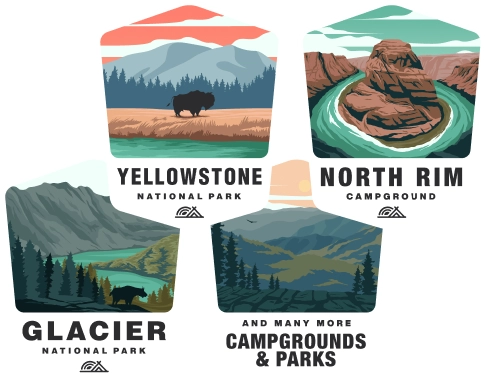Camping at Glacier National Park
Overview of Glacier National Park Camping
Glacier National Park, located in Montana's Rocky Mountains, is renowned for its stunning peaks, glaciers, and a multitude of hiking trails. There are thirteen developed campgrounds with over a thousand sites, providing options ranging from primitive backcountry experiences to RV-friendly spots with some amenities.
Campground Reservations and Availability
-
Reservation Campgrounds: Some campgrounds in the park operate on a reservation basis due to their popularity. Reservations can be made through the National Recreation Reservation System and it’s highly recommended you book as early as possible.
-
First-Come, First-Served Campgrounds: Several campgrounds in Glacier National Park still operate on a first-come, first-served basis, but these can fill up quickly, especially during peak season in the summer.
Backcountry Camping
-
Backcountry Permits: For those seeking a more solitary experience, backcountry camping is available but requires a Backcountry Permit. These can be obtained in person at park permit offices.
-
Planning and Preparation: When planning for backcountry camping, always ensure you're ready for the wilderness. This includes understanding bear safety, Leave No Trace principles, and being prepared for changing weather conditions.
Camping Fees
Fees for camping in Glacier National Park vary depending on the type of campsite and services available. Generally, front-country campsites with amenities will cost more than primitive backcountry sites.
Campground Facilities and Amenities
-
Services Available: Facilities at developed campgrounds might include flush toilets, potable water, picnic tables, fire pits, and, in some cases, dump stations. More primitive campsites may have pit toilets and no water available.
-
RV Camping: RVs are welcome in the park, though not all campgrounds can accommodate larger RVs, and not all have hook-up facilities.
Campground Etiquette and Regulations
-
Wildlife Safety: It's critical to store food and scented items properly to avoid attracting bears and other wildlife.
-
Quiet Hours: Generally, quiet hours are from 10:00 PM to 6:00 AM. Generators are only allowed during specific hours.
-
Campfire Rules: Campfires are permitted only in designated fire areas and subject to fire danger restrictions. Always fully extinguish fires before leaving.
Preparing for Your Trip
-
Weather and Clothing: The park's weather can be unpredictable. Dress in layers and be prepared for sudden changes, including snow, even in summer.
-
Food and Supplies: Some campgrounds are quite remote, so bring all the food and supplies you’ll need, or be prepared to travel to local towns.
Safety and Wildlife Encounters
-
Bears and Wildlife: Glacier is bear country. Carry bear spray, make noise while hiking, and know what to do in an encounter.
-
Stay on Designated Trails: For your safety and to protect the ecosystem, always stay on marked trails and avoid sensitive areas.
Visiting During Peak Season
If you plan to visit in peak season (July and August), expect campgrounds and trails to be busy. An early start can help avoid crowds, and mid-week visits might be slightly less congested than weekends.
Perennial Considerations and Impact
-
Leave No Trace: Follow Leave No Trace principles to minimize your impact on this pristine environment.
-
Parking and Transport: Parking at popular trailheads fills up early. Consider using the park's shuttle service when available.
Additional Resources and Information
-
Park Information Centers: Visit the park’s visitor centers for the most current information, maps, and advice from rangers.
-
Park Website and Social Media: Up-to-date information on campground availability, weather, and park advisories can often be found on the park's official website or social media channels.
Camping in Glacier National Park is a remarkable experience that requires careful planning and respect for the natural environment. Being well-prepared ensures not only a more enjoyable visit but also the protection of this unique wilderness for future generations.

